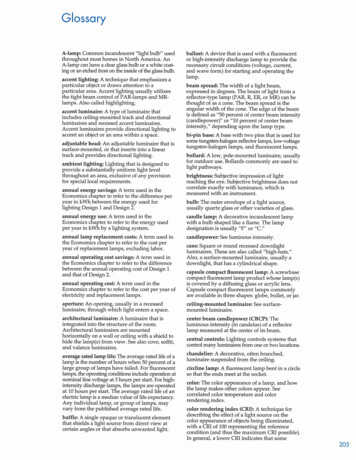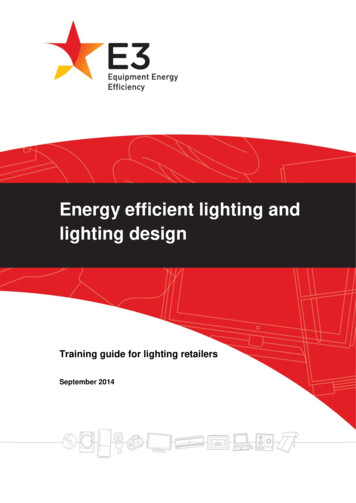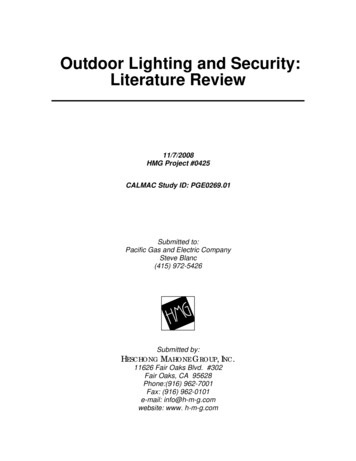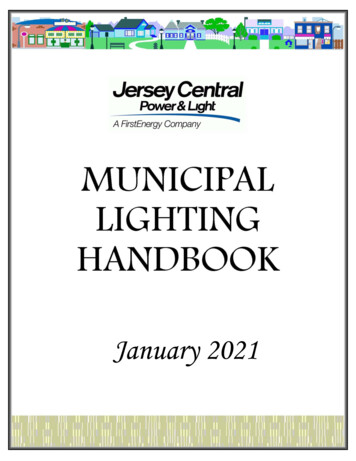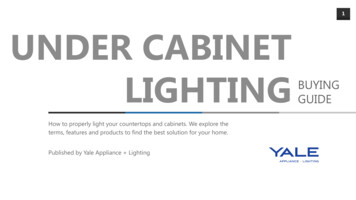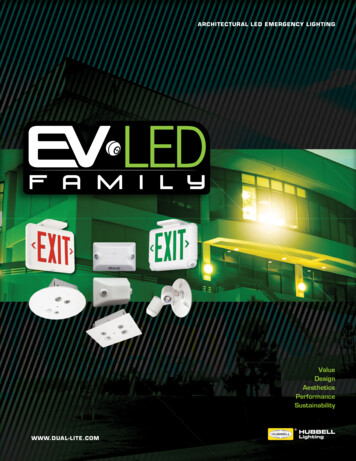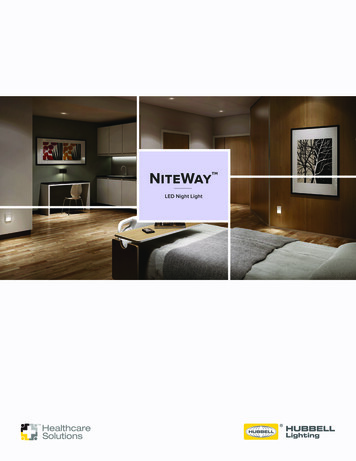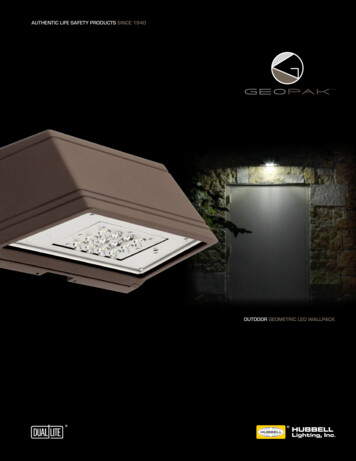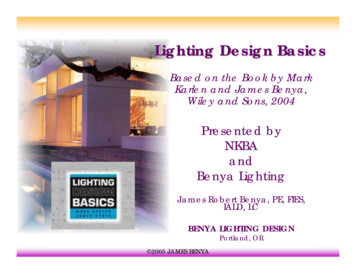
Transcription
Lighting Design BasicsBased on the Book by MarkKarlen and James Benya,Wiley and Sons, 2004Presented byNKBAandBenya LightingJames Robert Benya, PE, FIES,IALD, LCBENYA LIGHTING DESIGNPortland, OR 2005 JAMES BENYA
No Handouts?!?!? Get the book– www.wiley.com Download this presentation atwww.benyalighting.com Questions? Send a message tojbenya@benyalighting.com 2005 JAMES BENYA
What are lighting designbasics?1.2.3.4.5.6.7.8.9.IntroductionLight SourcesLuminairesSwitching and DimmingDaylightingLighting CalculationsDocumenting Lighting DesignThe Layers ApproachA Basic Approach 2005 JAMES BENYA
What are lighting designbasics?10. Residential Lighting Design11. Office and Corporate LightingDesign12. Hospitality Lighting Design13. Health Care/Institutional LightingDesign14. Lighting for Stores15. Lighting Common Spaces 2005 JAMES BENYA
What are lighting designbasics?16. The Professional Process ofLighting Design17. Collaborating with LightingDesigners18. Computers and Lighting Design19. Developing Skills Beyond theBasics 2005 JAMES BENYA
1 IntroductionA GOOD LIGHTING DESIGN SHOULD Look good! Provide the proper amount of light in everyroom. Be built and constructed within budget, code,and other constraints. Be environmentally responsible. Respond to the Architecture and Interior Design Produce good color Achieve the desired moods of each space Be able to control the lights 2005 JAMES BENYA
2 Light Sources Incandescent Halogen Fluorescent CompactFluorescent Lamps LED’s Fiber Optic Sources 2005 JAMES BENYA
Incandescent Lamps Appealing Warm, attractive color(2600-2900K) Dimmable Wide variety Not energy efficient 2005 JAMES BENYA
Low Voltage IncandescentLamps Usually lowwattage but notinherently energyefficient Greatestadvantage: sizeXenon incandescent strip lights2800K 2005 JAMES BENYAPAR36 Longthrow displaylamp 2700KLowvoltagestrips andtubes24002600K
Halogen Lamps Appealing Crisp warm, attractivecolor (2800-3100K) Dimmable Wide variety Longer life, slightlymore energy efficient 2005 JAMES BENYAHalogen PAR 20, PAR 30and PAR 38 lampsHalogen lamps fortable lamps andchandeliers
Low Voltage Halogen Compact, bright lamps A bit more energyefficient Excellent reading, workand display light sources Color Temp: 2900-3100K Long lifeSmall halogen lamps fortask lights, sconces, etc.PAR36 andAR111halogenlong throwlampsMR16 2005 JAMES BENYA
Linear Fluorescent T-12 “fat tubes”no longer agood choice Use T-8 lamps formost residentialuses Consider T-5 andT-2 lamps forundercabinetfixturesT-12 2005 JAMES BENYAT-8T-5T-2
CompactFluorescent 7,9, and 13 watttwin tubes (“PL”lamps) for steplights, low levellighting Triple tube,Circuline and2D lamps 18-58watts forgeneral lighting 2005 JAMES BENYA
Color temperatureRange 5000K4100KSettingSunCold7500K6500KRange ofFluorescentRangeofFlameRange ofIncandescentand Halogen 2005 JAMES BENYA10000K9000KNorthSky
Recommended FluorescentLamps for Common UseDesired LampColor Warm 2700K Warm 3000K Neutral 3500K Cool 4100K Cold 5000KLamp ColorDesignation “827” “830” or “930” “835” “841” “850” or “950”Example: F32T8/830 is a 3000K, 32 watt tubularfluorescent lamp 8/8” in diameter 2005 JAMES BENYA
Fluorescent Ballast Technology Non-dimmingelectronic ballasts– Quieter– Instant starting Dimmingelectronic ballasts– Two wire versions nowavailable– Standard 3 wire and 4wire versions alsoavailable 2005 JAMES BENYA
New Technologies Fiberoptics LED 2005 JAMES BENYA
Fiberoptics as Special Effect End-emittingfiber– twinkle effects (starfields)– in-water effects(ponds and waterfeatures) Side Emittingfiber– outlining– shapes 2005 JAMES BENYA
Fiberoptics as DisplayLighting Uses special opticalelements (small lenses) Each fiber emits a very smallamount of light Maximum bundle is about300 cd at 30 degree Virtually no UV or IR Requires a low ambient lightspace like a fine museum 2005 JAMES BENYA
LED Lights Promisingtechnology Used for trafficsignals and exitsigns New productsinclude sconces,step lights andmarker lights 2005 JAMES BENYA
For the Kitchen and BathMy favoritesKitchen PAR38 halogenwork areadownlights MR16 low voltageaccent lights Low voltage xenonor fluorescentundercabinet lights Fluorescent covelightsBath Halogen orfluorescent vanitylights MR16 vanitydownlight andaccent lights MR16 shower light 2005 JAMES BENYA
Urban Living Trends Smaller, higher quality spaces Green design 2005 JAMES BENYA
Challenges of Green Design Too much emphasis oncompact fluorescentlighting Little understanding oflighting design by utility andenergy efficiencyadvocates Not many good choices ofluminaires embodyinggreen principles Poor design sensitivity in thegreen community 2005 JAMES BENYA
For the Kitchen and BathMy green favoritesLook for US EPA Energy Star but be picky!Kitchen Compactfluorescent workarea downlights MR16 low voltageaccent lights Low voltagefluorescentundercabinet lights Fluorescent covelightsBath Fluorescent vanitylights MR16 vanitydownlight andaccent lights MR16 shower light 2005 JAMES BENYA
3 Luminaires “Architectural”– Recessed cans– Track– Coves and undercabinet lights mps Utility– Drums– Closet lights 2005 JAMES BENYA
Recessed Lighting Generally inexpensive Very popular Aesthetically “neutral” Good for task lighting OK for general lighting If chosen correctly,excellent for displaylighting and a number ofspecial applications 2005 JAMES BENYA
Recessed Lighting The “Housing”– For most residentialuse, fixtures are atmost about 7” tall for2x8 construction The “Trim”– 4”, 5” and 6”incandescent– 3”, 4”, 5” and 6” lowvoltage– 4”, 5” and 6”compact fluorescent 2005 JAMES BENYA
Standard Housings Incandescent non-IC Incandescent IC Incandescent air tight IC Low voltage non-IC Low voltage IC Low voltage airtight IC Compact fluorescent nonIC Compact fluorescent IC Compact fluorescentairtight IC 2005 JAMES BENYA
Remodeler Housings Designed to fitthrough asingle hole inthe ceiling Usually not IC 2005 JAMES BENYA
Premium Housings Superior quality Interchangeablelamp capability– Incandescent– Low voltage– Compact fluorescent High qualityinterchangeabletrims 2005 JAMES BENYA
Choosing Trims Is the trim suitable for your needs– Adjustable?– Right style?– Right color or material? Is the trim LISTED for the application?–––––Kitchen: indoor, dry locationBathroom: indoor, dry locationOver shower or tub: Spa or shower ratedSteam shower: wet label, gasketedIndoor pool or hot tub: wet label, non conductivetrim, at least 7.5’ above water level 2005 JAMES BENYA
Standard trims Downlight– Baffle– Cone Accent light– Gimbal– Eyeball– Pull down Wallwash– Eyelid 2005 JAMES BENYA
Using StandardRecessed Lighting Choose trims tastefully Use halogen lamps– 4” family use PAR20– 5” and 6” family usePAR30– 6” family also consider thePAR38– Avoid so called linevoltage MR16 and PAR16 2005 JAMES BENYA
AdjustableLine VoltageRecessedTrims 2005 JAMES BENYA
Low Voltage MR-16 Lighting Typically used in a 3” or 4”recessed can Can be used (with the righttrim) in a 5” or 6” can Use good quality MR16 lamps ALWAYS use a soft focusspread lens (Halo L111) Current Favorite: Sylvania37MR16/IR 2005 JAMES BENYA
Low Voltage Trims 2005 JAMES BENYA
Other Low Voltage Trims Glass trim,gasketed forwetenvironments Low cost spaand showerlight for tubsand showerstalls 2005 JAMES BENYA
Be Careful with CompactFluorescent Downlights Square: not IC orAT but looks nice Round IC – waytall To get an airtightIC you are limitedto 13 watts In the kitchendownlight youneed 32 watts 2005 JAMES BENYA
Track Still used in museums for good reason Permits maximum flexibility Luminaires equipped easily withspread lenses and UV filters for artworklighting Attaches to surface, permits dramaticlighting in condos 2005 JAMES BENYA
Track Standard 120 volttrack– Low cost generalpurpose– High cost “museumgrade” Low voltage track Low voltagespecialty systems– Two cable systems– Two rail systems– Two conductor “bars”,“rods”, and ribbons 2005 JAMES BENYA
Low VoltageLighting Most recessed lowvoltage lights have atransformer in thehousing Most low voltage stripsand some recessedhousings can beconnected to aremote transformer 2005 JAMES BENYA
Accent Lighting Using LowVoltage 2005 JAMES BENYA
Beam QualityAn unfiltered lamp tendsto have Striation– lines and harsh edges Halation– rings sometimes withrainbowing Sharp edges and rapidchange– well defined round orelliptical beams 2005 JAMES BENYA
Taming the (MR16) Beast Smooth the Beam– Softening Lens (HaloL111 or “solite”)– Spread Lens– Linear Lens Shield the Source– Baffle or snoot– Louver 2005 JAMES BENYA
Accent Lighting Technique Should be located at about30 degrees off verticalrelative to focal point Do not get too close to wall normally 24” minimum away Use 30-60-90 triangle todetermine optimum position Only use lighting systemscapable of hitting above 40degrees (off vertical) inspecial situations. 2005 JAMES BENYA
Accent LightingRecessed accent lightMounting LineTrack or monopoint30-60-90 triangleArtwork 2005 JAMES BENYAThe distance from thefixture to the artworkwill determinebeam angle andcandlepower
Accent Lighting with PAR36For high ceilings use a lowvoltage 6” recessed luminaireand a 50 watt PAR36 low voltagelamp 2005 JAMES BENYA
Accent lighting Living room, greatroom, family room Dining room Foyer Hallways/prime artlocations Art niches Master bedroomreading and art lights Powder rooms 2005 JAMES BENYA
The Layered Approach toLighting DesignBegin by thinking in layersDecorativeFocalTaskAmbient 2005 JAMES BENYA
Layer #1 - The Ambient orGeneral Lighting Layer Generally the relatively uniform lighting of thespace. Tends to establish mood. Includes uniform downlighting, indirect lighting(uplighting and wallwashing), and some specialtechniques, but can also be the decorativelighting Called “general lighting” if at task levels (30-50 fcor more). Called “ambient lighting” if lower than task levels 2005 JAMES BENYA
The Ambient LayerCove lighting 2005 JAMES BENYA
Layer #2 - The Task Layer Generally limited to “tasklighting” of the HORIZONTALWORK SURFACE at work locations. Tends to help create drama. Usually produces 50 fc or morewithin a small area. 2005 JAMES BENYA
Ambient and Task LightingDownlighting 2005 JAMES BENYA
Layer #3 - The Display orFocal Layer Generally limited to accent lightingand similar effects, primarily throughVERTICAL AND OTHER NONHORIZONTAL SURFACE ILLUMINATION. Tends to create drama, with greaterdrama the result of greater contrastbetween the brightness created byFocal Lighting and Ambient Lighting. Usually involves key displays at 100 fcor more. 2005 JAMES BENYA
Ambient, Task and FocalLightingAccent Lighting 2005 JAMES BENYA
Layer #4 - the Decorative orTraditional Layer In general, adds the decorativeluminaires called for by thearchitecture/interior design style,period, motif. Is usually expected to contribute tothe ambient illumination. In manydesigns, the decorative lighting will BEthe ambient lighting. Usually reduces contrast (drama). 2005 JAMES BENYA
Ambient, Task, Focal andDecorative LightingChandelier 2005 JAMES BENYA
Composition 2005 JAMES BENYA
Composition Chandelier(ambient anddecorative) Recessed (task) Recessed(focal) Sconce(decorative) 2005 JAMES BENYA
Composition Cove (ambient) Recessed (task) Undercabinet(task) Chandelier(decorative) Sconce(decorative) 2005 JAMES BENYA
Composition and Planningfor Change Recessedadjustablelighting Combinedwith fixedpredictablelighting 2005 JAMES BENYA
Remote transformers Address Article 411and 725 issues– Class 1– Class 2 Low noise, minimumheat 2005 JAMES BENYA
WallwashingProduces a flat,even wash of lightfor a wall. You mayfind this is NOT whatyou wanted 2005 JAMES BENYA
Types of WallwashersRececssed asymmetric styleEyelid styleRecessed lens styleTrack and surface lens andasymmetric styleSemi-recessed lensand open asymmetric style 2005 JAMES BENYA
Principles of Wallwashing Fixtures at least 24”out from wall andabout 1/4 wallheight out from wall Fixtures apart 1 to1.5 times thedistance from thewall If you don’t need atleast three - youshouldn’t bewallwashing 2005 JAMES BENYAThe higher thewall the furtherout to locatewallwashersAt least 2’
UndercabinetLightingDON’T Mount fixtures atback of cabinet Use luminous frontfixtures Put short fixturesunder longcabinets Put in cheap coolwhite or daylightlamps 2005 JAMES BENYA
UndercabinetLightingDO Use solid front fixtures Use a lens to diffusethe lamp image overpolished countertops Choose fixtures to beas continuous aspossible and wraparound corners 2005 JAMES BENYA
Low Voltage SpecialtyLighting Permits finely detailed lighting effects Use inside and under cabinets andsimilar locations 2005 JAMES BENYA
Example: Bookcase 2005 JAMES BENYA
Example: Cabinet withPolished Countertop 2005 JAMES BENYA
Things to Remember: Roomby Room Here is my basic list of lightingconsiderations I use this with every client – weexpand from there 2005 JAMES BENYA
Kitchen Multiple layerspermits multiplemoods 2005 JAMES BENYA
Steps to Better Kitchen Lightingby LayersLayer #1 – Lightthe Task 2005 JAMES BENYA
Steps to Better Kitchen Lightingby LayersLayer #2 –AmbientLight 2005 JAMES BENYA
Steps to Better Kitchen Lightingby LayersLayer #3 –DecorativeLight 2005 JAMES BENYA
BathroomLayers Multiple layersfor mood andflexibility 2005 JAMES BENYA
BathroomLayer #1-TaskLight the Face 2005 JAMES BENYA
BathroomLayer #1-TaskLight the Face 2005 JAMES BENYA
BathroomLayer #2-TaskLight the Sink 2005 JAMES BENYA
BathroomLayer #3-TaskLight theShower orTub 2005 JAMES BENYA
BathroomLayer #4- NightLights 2005 JAMES BENYA
Other Lighting Things toRemember Controlled Dimmers anddaylightcontrols laid outwell and kept Lens, focus andsimpleotheradjustments must Layers in everybe donespace evenclosets Good lightingextends outdoors Built in night lights 2005 JAMES BENYA
Lighting Design BasicsPresented by BENYA LIGHTINGDESIGNFor a copy of these slides,www.benyalighting.com 2005 JAMES BENYA
A GOOD LIGHTING DESIGN SHOULD Look good! Provide the proper amount of light in every room. Be built and constructed within budget, code, and other constraints. Be environmentally responsible. Respond to the Architecture and Interior Design Produce good color




